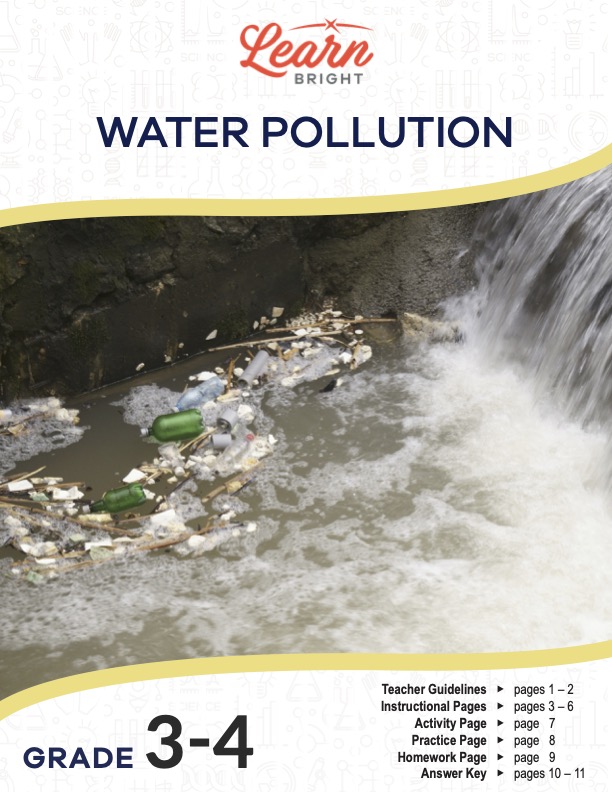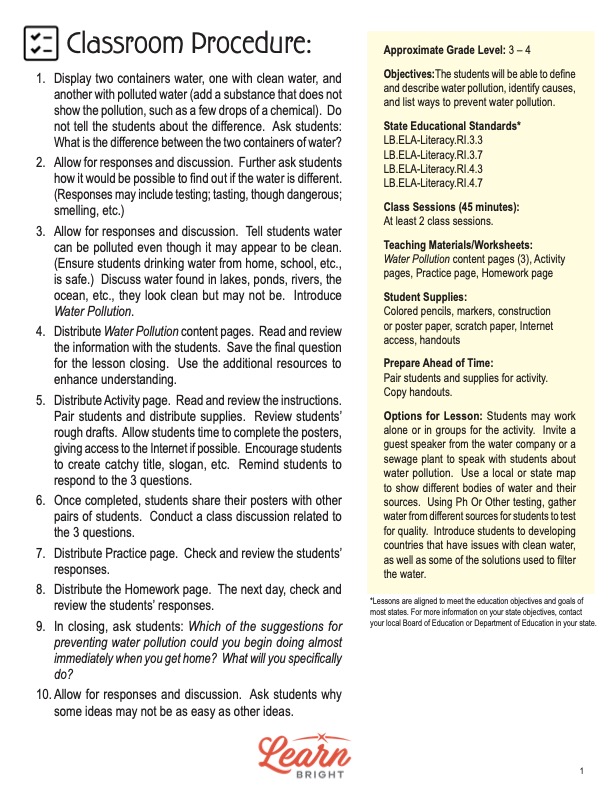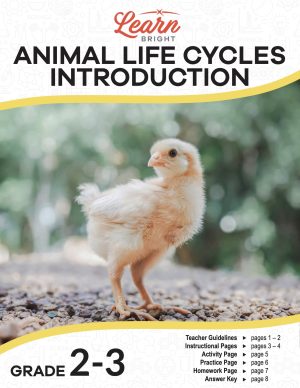Description
What our Water Pollution lesson plan includes
Lesson Objectives and Overview: Water Pollution explores the negative effects of pollutants in our water sources. Students will discover some causes and effects of water pollution, as well as some ways to prevent it. By the end of the lesson, they should understand why it is important to keep the world’s H2O sources clean. This lesson is for students in 3rd grade and 4th grade.
Classroom Procedure
Every lesson plan provides you with a classroom procedure page that outlines a step-by-step guide to follow. You do not have to follow the guide exactly. The guide helps you organize the lesson and details when to hand out worksheets. It also lists information in the yellow box that you might find useful. You will find the lesson objectives, state standards, and number of class sessions the lesson should take to complete in this area. In addition, it describes the supplies you will need as well as what and how you need to prepare beforehand. In addition to the handouts, this lesson requires colored pencils or markers, construction paper or poster boards, and scratch paper. You will also need to ensure students have internet access for researching purposes.
Options for Lesson
There are a number of suggestions in the “Options for Lesson” section of additional activities and tasks that you could incorporate into the lesson plan. One suggestion is to invite a guest speaker from the water company or a sewage plant to speak with the class and answer their questions. Another idea is to obtain a local or state map that shows various bodies of water and their sources. You could also use pH strips or some other kind of testing kit to test the quality of water samples that you gather from different sources. One last idea is to introduce students to developing countries that have problems with clean water and describe some solutions that people could use to filter it better.
Teacher Notes
This page provides an extra paragraph of information or guidance as you prepare the lesson. It stresses how important it is that students understand the effects of water pollution and points out that they could face these issues in their lives. Use the blank lines to write down any other ideas or thoughts you might have regarding the lesson material.
WATER POLLUTION LESSON PLAN CONTENT PAGES
Pollution
The Water Pollution lesson plan contains four pages of content. The first page provides students with some background information on what pollution is and why it is bad. All living organisms need food, oxygen, and water to survive. The main source of oxygen for humans is the air. If that air is not clean, however, it can cause health issues. People with asthma, for instance, have a hard time breathing when the air is dirty. In some countries, the air quality is bad enough that people have to cover their noses and mouths with a mask.
The reason behind dirty air has to do with pollution. Pollution includes substances in the environment that are harmful or dangerous for living things. Besides the air, it can also affect water and the land in general. Different types of pollution include air, noise, land, and light. Some of these cause only minor issues, but others can lead to serious problems for all living things. One of the worst kinds is water pollution. Because water is a necessity of life for all living organisms, polluted water causes a lot of issues in the world.
Students will discover that the human body is about 70% water, which is why drinking water regularly is good for their health. The water we consume needs to be clean. Even for plants, if the water is unclean, the plants will die or become unhealthy to eat. Water makes up 70% of the Earth’s surface, most of which is found in the oceans. Ocean water is salty, so it’s not safe to drink. Only 1% of the water on Earth is fresh water, which we find in lakes, rivers, streams, and reservoirs. If these sources become polluted and dirty, there is even less safe drinking water.
Water Pollution
Sadly, humans are the cause of much of the water pollution that exists. Polluted water is simply unsafe to drink. While humans should not drink salt water either, pollution in oceans is still bad. Humans may not be able to survive by drinking salt water, but the living organisms in the oceans can and do. Pollution is also bad for oceans because it can cause problems for all the aquatic life living in them.
When different particles, chemicals, and other substances cause water to become unsafe, the water becomes polluted. Sometimes those pollutants flow directly into the water from a factory. Other times, it flows indirectly from rainwater that mixes with farm chemicals or from construction sites or other places that release unsafe chemicals. All rainwater eventually seeps into the ground and flows into rivers, lakes, or streams. So if rainwater is polluted, the pollution will eventually affect the freshwater sources.
In some countries, unsafe drinking water is the leading cause of death. There are places in the world where people drink bad water because they have no other choice. They need water to survive. The pollution can happen naturally due to volcanoes, excessive algae, or silt from storms and floods. However, humans often contribute to the problem even more. Human causes include sewage, pesticides and fertilizers, chemicals, and trash.
Types of Pollution
The lesson lists eight types of water pollution: nutrients, surface water, oxygen depleting, ground water, microbiological, suspended matter, chemical water, and oil spillage. Nutrients pollution occurs when excessive algae and plant growth that takes place in water bodies release too many nutrients into the water. Too much algae, for instance, takes away the oxygen from the water, which means other organisms may die.
Similarly, oxygen depleting is when decaying matter is released into water, leading to more microorganisms that use up the oxygen. Some of these organisms even produce harmful chemicals that can kill other living things. Microbiological pollution happens when many people drink water directly from rivers or streams without first treating the water. The natural pollution in this water can cause illness to humans and other animals.
Suspended matter is when some pollutants do not dissolve in the water and instead sink to the bottom, killing organisms that live there. Chemical water pollution occurs when the chemicals people use end up in the water. It also includes metals and solvents from factories that are poisonous to aquatic life, which slows their growth, makes them infertile, or kills them.
Prevention Methods
Students will learn several ways that they can help prevent water pollution or assist in cleaning up polluted waters. Though some pollution is not possible to prevent, there are ways to help keep water clean. One of the first things we can do is inform others about the effects of polluted water and explain why keeping water clean is essential to survival.
The lesson lists several facts students could share with others to inform them of the issue. Around 14 billion pounds of mostly plastic garbage ends up in the water every single year. In the United States alone, 1.2 trillion gallons of sewage is dumped into the water each year. Nearly 90% of wastewater flows untreated into lakes, rivers, and coastal areas. Over 3 million children under the age of five die every year because of diseases caused by drinking polluted water and poor sanitation. Nearly 1 billion people in the world don’t even have access to clean water sources.
Students can then read through five suggestions of things they can do to prevent polluting water themselves. They can first reduce the amount of water they use when doing things like taking showers or brushing their teeth. They should also not dump paints, oils, medicines, or chemicals down the drain or into the toilet. Another suggestion is to encourage their parents to buy cleaning supplies that are eco-friendly. One other great option is to plant more trees and flowers.
WATER POLLUTION LESSON PLAN WORKSHEETS
The Water Pollution lesson plan includes three worksheets: an activity worksheet, a practice worksheet, and a homework assignment. Each one will help reinforce students’ comprehension of the lesson material. The guidelines on the classroom procedure page outlines when you give your students each handout.
PREVENTION POSTERS ACTIVITY WORKSHEET
Students will work with a partner for the activity. Using the supplies you provide, they will create a poster that encourages people to prevent water pollution. They will need to be creative and use words, images, logo, and slogans to demonstrate why this is important. In addition to a catchy title and the images and slogans, they should include facts that relate to the concept of preventing pollution. After they complete their poster, they will respond to three questions at the bottom of the worksheet.
MULTIPLE CHOICE PRACTICE WORKSHEET
For the practice worksheet, students will answer 10 questions. You can choose whether or not students can use the content pages for reference when they need help. This worksheet could also work well as a quiz if you want to test students on their level of comprehension.
WATER POLLUTION HOMEWORK ASSIGNMENT
The homework assignment has two sections. The first section contains 12 statements. Students must match the type of pollution from the word bank to the statements. They will use some terms more than once. The second section requires students to fill in the blanks in eight sentences. There is no work bank for this section, so students will need to remember what they learned during the lesson. However, like the practice worksheet, you may choose to allow them to use the content pages for help if they need it.
Worksheet Answer Keys
The last two pages of the lesson plan document are answer keys for the practice and homework worksheets. The answers are all in red to make it easy for you to compare to students’ responses. Because there are no open-ended or opinion-based prompts, students’ answers should mirror those on these pages. If you choose to administer the lesson pages to your students via PDF, you will need to save a new file that omits these pages. Otherwise, you can simply print out the applicable pages and keep these as reference for yourself when grading assignments.









